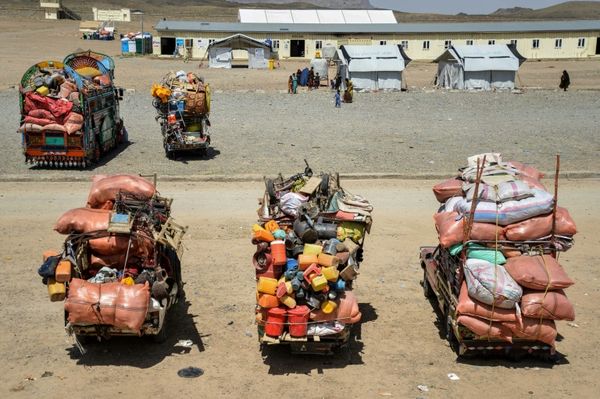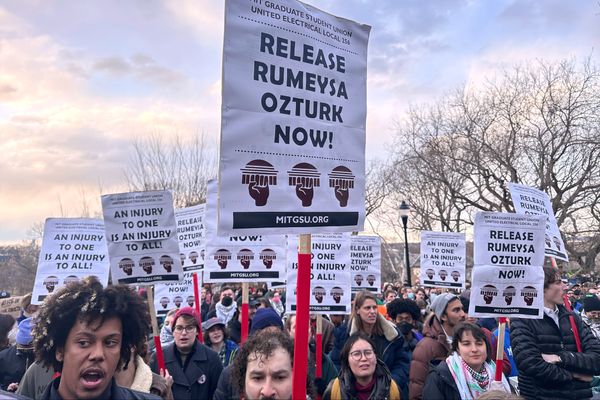
Painted with the support of the city council in 2017, a mural spanning the entire side of a six-story building in Guayaquil’s financial district went largely unnoticed for more than a year in Ecuador’s most populous city – until it triggered outrage.
The painting showed two men grappling over money: one dressed in a suit, tie and shoes, with fair skin; the other shirtless, in shorts, flip-flops and a stocking mask. He was dark-skinned.
For Black activists, the artwork’s message left no room for doubt: it implied a robbery and reinforced racist stereotypes, smearing Ecuador’s Afro-descedent minority, which suffers the worst outcomes in rates such as unemployment and gender-based violence.
“It was an offence to the Black people of Guayaquil,” said Guillermo Leones Pacheco, 62, president of the Pueblo Negro organisation, who was one of the leading figures in the campaign against the mural.
That pressure ultimately led to the work’s removal in 2020 and the creation of six new murals depicting Black resistance.
One of them, in the city’s south-west, features eight Black historical figures, including María Chiquinquirá Díaz, an enslaved woman who, in the 18th century, sued her owners in Quito’s royal court in search of freedom. Although the case’s outcome is unknown, Díaz became an icon of Afro-Ecuadorian resistance.
“Despite our presence here since the city’s founding, there is a loss of identity regarding Black people in Guayaquil,” said Pacheco, one of a group of activists and artists fighting to preserve Black culture in Ecuador’s largest city.
Founded in 1535, Guayaquil was the main port during the Spanish colonisation, a status that continued after independence, making it Ecuador’s business and financial capital.
Before abolition in 1845, Guayaquil was also the primary centre for the slave trade, supplying cacao and tobacco plantations across the country. The city also had a significant Black population, both enslaved and free, including the hundreds who worked at the port.
Now, Afro-Guayaquileños mostly live in the impoverished belts of the city. They make up 6.9% of the city’s 2.746 million inhabitants – a higher rate than the national average of 4.8% – but they remain “invisible” to the authorities, says Carlos Valencia Lastra, 40, an activist for Black rights.
“Society makes us invisible because they know they owe us a historical debt and have deprived us of many opportunities,” said Lastra, who coordinates a community centre in Nigeria, one of Guayaquil’s poorest and most predominantly Black neighbourhoods. “They’ve made us believe that our culture, customs, and traditions are the worst.”
For this reason, he started a project to teach marimba to Black youths. The word originates from the Bantu language family and refers not only to the wooden instrument – also found in the Afro-Latin culture of countries like Mexico and Guatemala – but also to the rhythm, the dance and the culture itself.
“When you listen to the marimba, you heal your soul and mind. It empowers Black people and helps you decolonise your thinking,” said Lastra.
Last month, he and other marimberos played and sang during a chigualo – a funeral ritual of the Afro-descendent populations of coastal Ecuador and Colombia – in honour of four Black boys who were murdered after being detained by the military.
Activists from the Black movements argue that Afro-Ecuadorians are among the main victims of the numerous human rights violations committed during the “war on drugs” imposed a year ago by the country’s president, Daniel Noboa, in response to the surge in crime.
“We need to defend ourselves from the oppression and discrimination we face,” said Maria Nazareno, 36, who also attended the chigualo and teaches another Afro-Ecuadorian musical genre to Black children: the bomba, in which performers balance a glass bottle on their head as they dance.
“We cannot let this historical memory be lost,” she said.
But artists fear that some parts of Afro-Ecuadorean culture are at risk of disappearance.
“This is our greatest concern,” said Orlin Montaño, 48, a professor of traditional Afro-Ecuadorian music at the Universidad de las Artes and one of the few remaining marimba-makers in the country.
It takes about 15 days to build the instrument, traditionally made from palm trees. But young people are losing interest in continuing the tradition, he said. “There is a strong interest in music from abroad, particularly from the United States, and not so much in what is ours,” he said, also lamenting the lack of financial support from the government.
“If the state were truly interested in combating racism, it would start with education, reminding everyone that we have the same rights and obligations as any other Ecuadorian. A white or mestizo child isn’t born racist; it’s society that makes them racist,” said Montaño.







